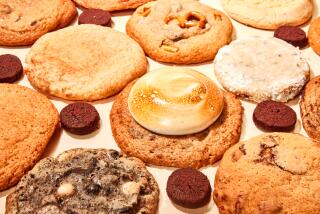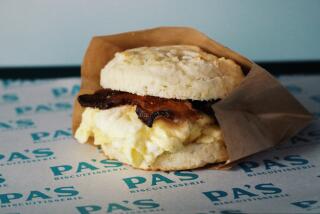Biscuits Rise Again : Home Cooking: Aroma of good times will fill the kitchen in 20 minutes
Moving into the kitchen of a short-term rental is almost a type of entertainment, because every item (or absence thereof) seems to have a story to tell.
The battered angel cake pan attests to a baker, a serious cook, a maker of nice-in-the-kitchen. Spice tins dusty with age and unuse suggest that the baker goes back a few tenants. Each fork appears to have been to the wars, tines akimbo, plate worn off. There is one measuring cup. No measuring spoons. Six loaf pans. No kettle. Of course, this kind of entertainment wears thin pretty quickly if you like to cook, expect to cook and have, in a fit of minimalism, brought only the rock-bottom basics: good knives, the processor, a couple of jars of brandied cherries. But it’s an interesting reminder of what’s important and what’s not.
Measuring, for instance, doesn’t matter a hoot most of the time. You can serve soup, beans and the like with a big spoon and a coffee cup, if your new abode comes ladle-less. But you can’t get far without a kettle. Boiling pasta in a stainless-steel mixing bowl is--and should be--a once-in-a-lifetime experience.
And you keep missing familiar things: the little saucepan that’s just the right size for one portion of soup; the blue enamel roasting pan that almost says “chicken,” having held so many; the huge old china washbowl that’s perfect for tossing salads and mixing bread dough.
If your stay turns out to be longer than anticipated, most of the essentials will be purchased--ideally at a second-hand store. Kitchen life will fall into the old routine. The supermarket with the best produce department will be located, along with the cheese shop and health-food store. But in the meantime, the first order of business is to make the place taste and smell like home, preferably by baking a nice batch of biscuits, the quickest of all quick breads and, since pioneer days, the food of homemakers away from home.
Homemade biscuits are delicious, far tastier than the “ready-to-bake” refrigerated type or those made from biscuit mix. They have the fresh flavor of real butter, no aroma of preservatives. The ingredients are always there. Measuring implements, while helpful, aren’t absolutely essential. And the whole project takes fewer than 20 minutes, counting baking time. Who, in view of all these virtues, could say them nay? Even people who have been in the same home for years love to bake biscuits.
BISCUITS
2 cups minus 1 tablespoon flour
1/2 teaspoon salt
2 teaspoons Bakewell Cream and 1 teaspoon baking soda or 2 1/2 teaspoons baking powder
1/4 cup cold butter, cut in 4 or 5 pieces
3/4 cup cold milk
Combine flour, salt and Bakewell Cream in large, shallow bowl. Stir with wire whisk until thoroughly mixed. Using fingertips or pastry blender, work in butter until mixture is texture of coarse cornmeal.
Make well in center and pour milk in all at once. Stir dough together as quickly as possible, using only 8 or 10 strokes, then turn onto lightly floured surface and knead 5 or 6 times, just until barely smooth. (Dough should be tender but not sticky.)
Gently roll or pat dough out 1/2-inch thick. Cut circles with biscuit cutter or use sharp knife to cut dough into squares. Set on ungreased baking sheet, well separated for crisp biscuits, close together for soft-sided ones--and bake at 450 degrees about 12 to 15 minutes, or until well risen and browned. Serve hot from oven. Makes about 16.
Note: Bakewell cream is based on sodium acid pyrophosphate, which, like cream of tartar, makes homemade baking powder when combined with baking soda. It’s preferable to conventional baking powders because it leaves no metallic taste in the finished product. Distribution is limited outside of New England, but it can be inexpensively mail-ordered from the Apple Ledge Co., Box 6640, East Holden, Maine 04429. (207) 942-5532.
Variations:
WHOLE GRAIN BISCUITS are stodgy, alas. But up to 1/2 of the flour may be whole wheat with no loss of loft or loveliness. Alternatively, up to 1/2 cup of cornmeal may replace that much flour. The texture will be agreeably sandy and the flavor nicely nutty. Try adding a tiny dash of clove to cornmeal; it accentuates the corn flavor.
TEA BISCUITS: Add 2 tablespoons sugar and grating of nutmeg to dry ingredients. Increase butter to 6 tablespoons, or replace 1/3 cup of milk with 1/3 cup whipping cream. Roll generous 1/4-inch thick and bake 8 to 10 minutes.
BISCUIT DICTA: Though the finished product is used as bread, the rules for good biscuits are like those for good pie crust: Keep ingredients cold and handle dough as little as possible. This keeps things flaky, since flakiness comes from having little beads of fat surrounded by flour. And it keeps them tender. Toughness results from the development of gluten when dough is kneaded.
As with pie crust, the greatest flakiness comes from lard. Its large fat crystals and lower water content makes it more conducive to flake formation than butter. Biscuits made entirely with lard taste rather bland, though. As with pie crust, scant half lard and generous half butter is good compromise.
For tall, even biscuits, be sure to use sharp cutter and to cut straight down, without twisting. If edges are compressed as they are cut, biscuits will not be able to rise fully.
Making biscuits without measuring implements: Remember that large mugs hold more than one cup of flour, coffee cups little bit less. Regular teaspoons hold a bit more than measuring teaspoons. Butter is marked right on the wrapper. Proceed as directed, simply eyeballing all measurements, but hold back couple of tablespoons of milk when you first add it. Do about half stirring and then add more milk if needed. If mixture comes out too soft to roll, make drop biscuits instead, dropping them onto greased baking sheet.
More to Read
Eat your way across L.A.
Get our weekly Tasting Notes newsletter for reviews, news and more.
You may occasionally receive promotional content from the Los Angeles Times.










